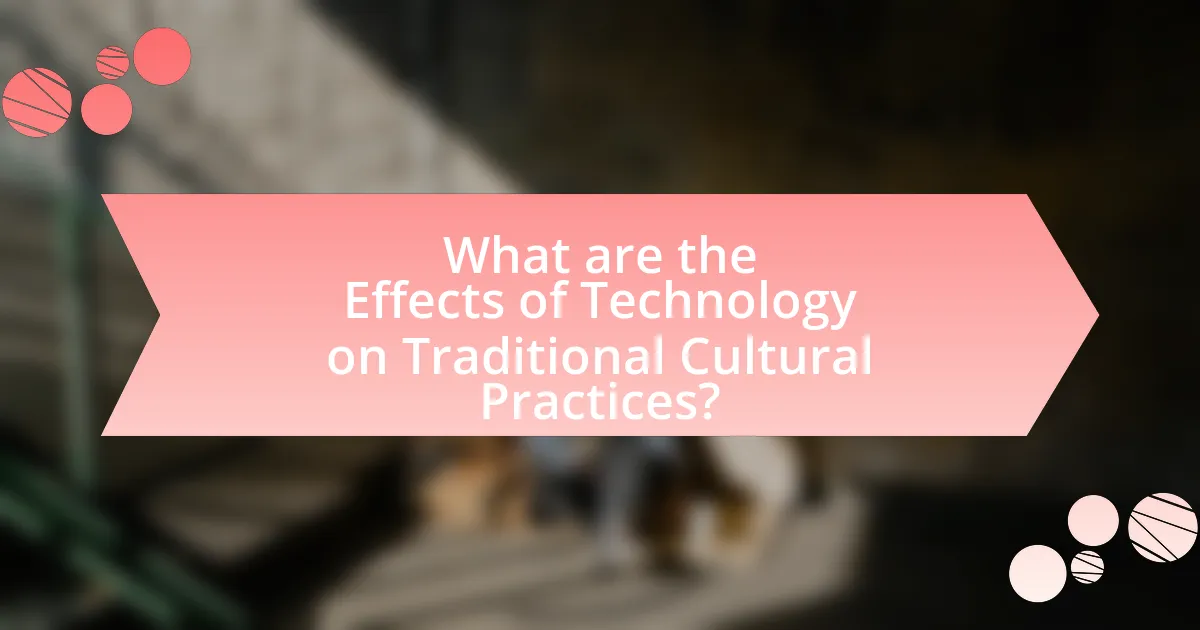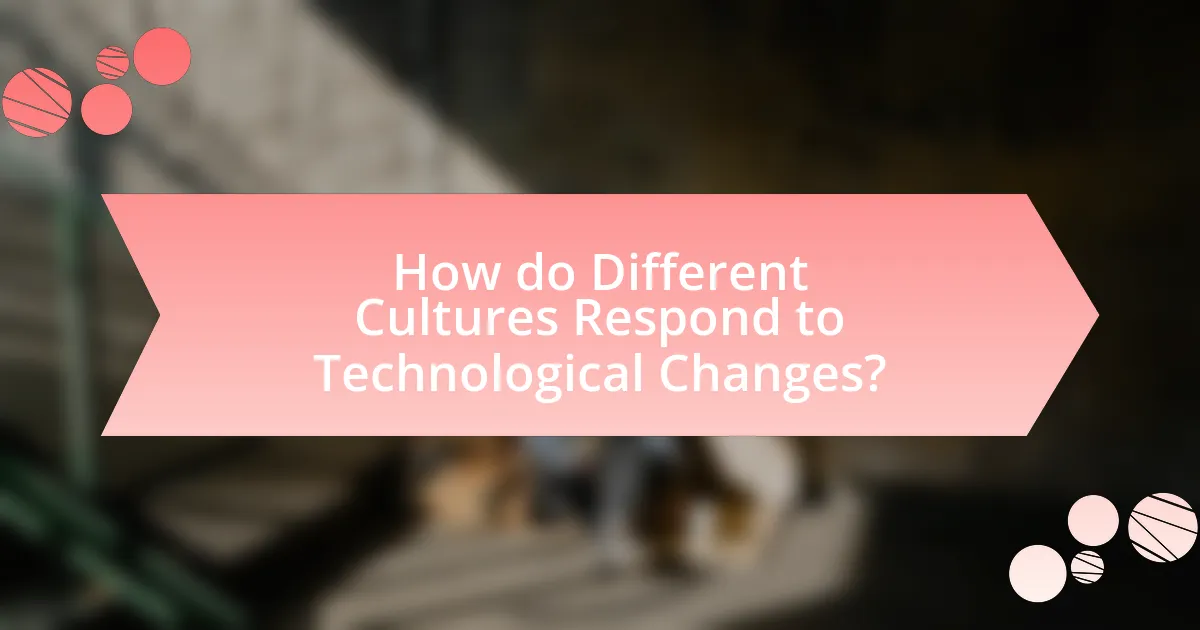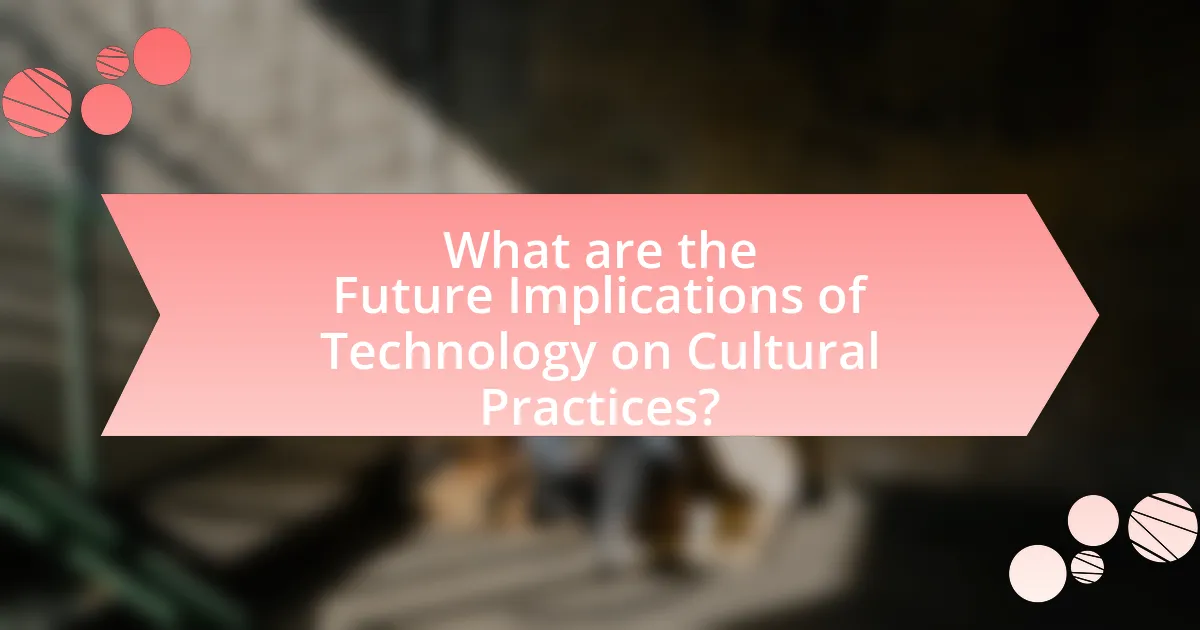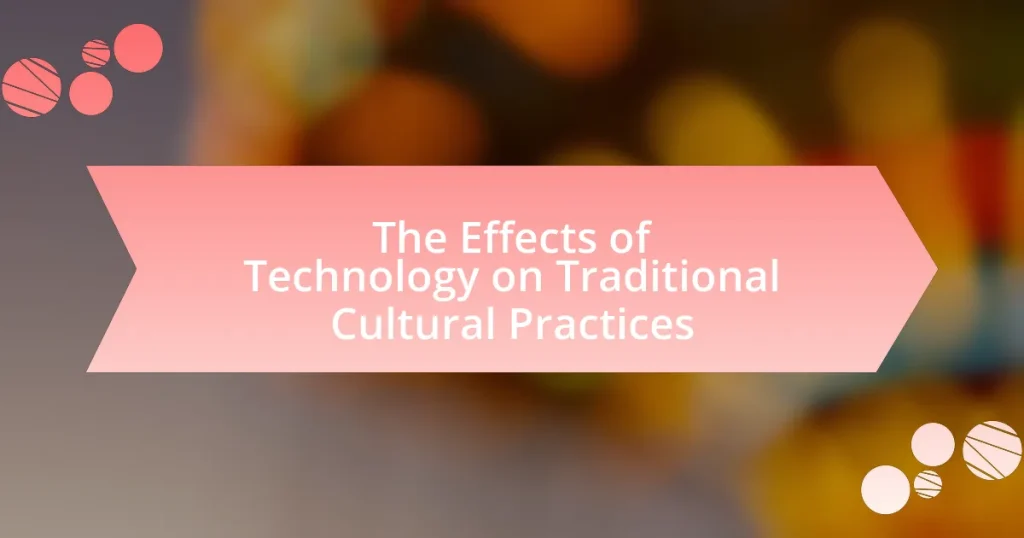The article examines the effects of technology on traditional cultural practices, highlighting how advancements in communication and digital tools influence cultural expressions, preservation, and transmission. It discusses the dual impact of technology, which can both enhance cultural visibility and lead to homogenization, diluting unique identities. Key technologies such as digital archiving, social media, and augmented reality are explored for their roles in preserving cultural heritage and facilitating cultural exchange. The article also addresses challenges posed by globalization, cultural appropriation, and varying cultural responses to technological changes, emphasizing the need for strategies that balance tradition and innovation.

What are the Effects of Technology on Traditional Cultural Practices?
Technology significantly alters traditional cultural practices by introducing new methods of communication, altering social interactions, and influencing cultural expressions. For instance, the rise of social media platforms allows for the rapid dissemination of cultural content, which can lead to the globalization of local traditions. This phenomenon can dilute unique cultural identities as traditional practices are adapted to fit modern digital formats. Additionally, technology facilitates the preservation of cultural heritage through digital archiving, enabling communities to maintain their traditions in a rapidly changing world. Research indicates that while technology can enhance cultural exchange, it may also lead to cultural homogenization, where distinct practices become less recognizable due to widespread adoption of global trends.
How has technology influenced the preservation of traditional cultural practices?
Technology has significantly influenced the preservation of traditional cultural practices by enabling documentation, dissemination, and revitalization efforts. Digital tools such as video recording, social media, and online archives allow communities to capture and share their cultural heritage, making it accessible to a global audience. For instance, the use of platforms like YouTube has facilitated the sharing of traditional music and dance, helping to keep these practices alive among younger generations. Additionally, initiatives like the UNESCO Intangible Cultural Heritage Lists utilize technology to promote awareness and support for endangered cultural practices, ensuring they are recognized and preserved for future generations.
What technologies are most commonly used in preserving cultural heritage?
The technologies most commonly used in preserving cultural heritage include 3D scanning, digital archiving, and augmented reality. 3D scanning allows for the accurate capture of artifacts and sites, enabling detailed digital replicas that can be studied and shared without physical handling. Digital archiving involves the systematic storage of documents, images, and audio recordings, ensuring that cultural materials are preserved for future generations. Augmented reality enhances the experience of cultural heritage by overlaying digital information onto physical sites, providing interactive educational opportunities. These technologies are validated by their widespread application in projects like the digitization of the British Museum’s collection and the use of 3D models in the restoration of ancient sites such as Pompeii.
How do these technologies impact the authenticity of cultural practices?
Technologies impact the authenticity of cultural practices by altering how traditions are expressed and perceived. Digital platforms enable broader dissemination of cultural elements, which can lead to both preservation and dilution of authenticity. For instance, social media allows for the rapid sharing of cultural practices, but it can also result in misrepresentation or commercialization, as seen in the case of traditional dances being adapted for viral trends. Research indicates that while technology can enhance cultural visibility, it may simultaneously challenge the integrity of cultural expressions, as noted in studies examining the effects of globalization on indigenous practices.
In what ways has technology altered the transmission of cultural knowledge?
Technology has significantly altered the transmission of cultural knowledge by facilitating rapid and widespread dissemination through digital platforms. The advent of the internet and social media allows cultural practices, traditions, and languages to be shared globally, reaching audiences that were previously inaccessible. For instance, platforms like YouTube and TikTok enable users to showcase traditional dances, music, and rituals, preserving and promoting cultural heritage in real-time. Additionally, online educational resources and virtual museums provide access to cultural artifacts and historical contexts, enhancing understanding and appreciation. Research indicates that digital storytelling has become a vital tool for cultural preservation, as seen in projects like the “Digital Public Library of America,” which aggregates cultural resources from libraries and archives across the United States, making them available to a broader audience.
What role do digital platforms play in sharing traditional practices?
Digital platforms serve as vital tools for sharing traditional practices by enabling widespread access and engagement with cultural heritage. These platforms facilitate the dissemination of knowledge, allowing communities to showcase their traditions through videos, social media, and online forums. For instance, platforms like YouTube and Instagram have been instrumental in promoting traditional crafts, music, and rituals to global audiences, thereby preserving and revitalizing cultural practices that might otherwise fade away. Research indicates that digital storytelling can enhance cultural transmission, as seen in studies highlighting how indigenous communities utilize social media to share their narratives and practices, fostering a sense of identity and continuity.
How has the accessibility of information changed cultural education?
The accessibility of information has significantly transformed cultural education by enabling broader access to diverse cultural resources and knowledge. This shift allows individuals from various backgrounds to engage with and learn about different cultures through online platforms, digital libraries, and educational websites. For instance, UNESCO reports that digital resources have increased the availability of cultural heritage materials, making it easier for learners to explore global traditions and practices. Consequently, this democratization of information fosters greater cultural awareness and appreciation, as individuals can now access educational content that was previously limited to specific geographic or socioeconomic groups.
What challenges does technology pose to traditional cultural practices?
Technology poses significant challenges to traditional cultural practices by promoting globalization and homogenization, which can dilute unique cultural identities. For instance, the widespread use of social media and digital communication allows for rapid dissemination of cultural trends that often overshadow local customs. A study by the United Nations Educational, Scientific and Cultural Organization (UNESCO) highlights that over 80% of cultural expressions are influenced by global media, leading to a decline in traditional practices as communities adopt more mainstream, globalized behaviors. Additionally, technology can create generational divides, where younger individuals may prioritize digital engagement over traditional cultural activities, further eroding the transmission of cultural knowledge.
How does globalization through technology threaten local traditions?
Globalization through technology threatens local traditions by promoting homogenization of cultures, leading to the erosion of unique cultural identities. As global communication and digital platforms facilitate the rapid spread of dominant cultural narratives, local customs, languages, and practices often become marginalized. For instance, the prevalence of Western media and entertainment can overshadow indigenous storytelling traditions, resulting in a decline in their practice and transmission. Research indicates that over 90% of online content is produced in a handful of languages, primarily English, which further diminishes the visibility of local languages and traditions. This technological influence can create a preference for globalized cultural products, thereby undermining the value and relevance of local traditions.
What are the risks of cultural appropriation in the digital age?
Cultural appropriation in the digital age poses significant risks, including the commodification of cultural elements, misrepresentation, and the erasure of original cultural contexts. The rapid sharing of cultural content online can lead to the exploitation of marginalized cultures, where elements are taken without permission or understanding, often resulting in financial gain for those outside the culture. For instance, the use of traditional Indigenous designs in fashion by non-Indigenous designers can dilute their meaning and significance, as seen in cases where brands profit from cultural symbols without acknowledging their origins. Additionally, digital platforms can amplify stereotypes and reinforce power imbalances, as dominant cultures may misinterpret or oversimplify the complexities of minority cultures, leading to harmful narratives. This dynamic is evident in social media trends that appropriate cultural practices, often stripping them of their significance and reducing them to mere aesthetics.

How do Different Cultures Respond to Technological Changes?
Different cultures respond to technological changes in varied ways, influenced by their values, beliefs, and social structures. For instance, in Japan, technology is often embraced and integrated into daily life, enhancing traditional practices such as tea ceremonies through automation and digital tools. Conversely, some Indigenous cultures may resist technological changes to preserve their traditional ways of life, viewing technology as a threat to cultural identity. Research by the Pew Research Center indicates that cultural attitudes towards technology can significantly affect its adoption, with societies valuing innovation more likely to adapt quickly. This demonstrates that cultural context plays a crucial role in shaping responses to technological advancements.
What are the varying attitudes towards technology in different cultural contexts?
Attitudes towards technology vary significantly across cultural contexts, influenced by historical, social, and economic factors. In collectivist cultures, such as Japan, technology is often embraced as a means to enhance community and social harmony, leading to widespread acceptance of innovations like robotics in daily life. Conversely, in some indigenous cultures, technology may be viewed with skepticism, as it can threaten traditional practices and values, leading to resistance against its adoption. For example, the Maasai community in Kenya has shown reluctance to adopt modern agricultural technologies, prioritizing their traditional pastoral lifestyle. These differing perspectives highlight how cultural values shape the acceptance and integration of technology, impacting traditional practices and societal structures.
How do indigenous cultures adapt technology to fit their traditional practices?
Indigenous cultures adapt technology to fit their traditional practices by integrating modern tools and methods that enhance their cultural expressions while preserving their heritage. For example, many indigenous communities utilize digital platforms to share traditional stories and art, thereby reaching wider audiences and ensuring the survival of their cultural narratives. Research indicates that the use of smartphones and social media allows for the documentation and dissemination of traditional knowledge, which is crucial for cultural continuity. A study by the University of Alberta highlights how the Cree Nation employs technology to teach language and cultural practices to younger generations, demonstrating a successful blend of modern technology with traditional education methods.
What examples exist of resistance to technology in preserving cultural identity?
Resistance to technology in preserving cultural identity is exemplified by the Amish community, which actively rejects modern technological advancements to maintain their traditional way of life. The Amish prioritize their cultural values, such as community and simplicity, over the conveniences offered by technology, leading them to limit the use of electricity, automobiles, and modern communication devices. This resistance is rooted in their belief that technology can disrupt social cohesion and erode their distinct cultural identity. Additionally, Indigenous groups worldwide often resist technological encroachment on their lands and practices, advocating for the preservation of traditional knowledge and customs against the pressures of globalization and industrialization. For instance, the Maori in New Zealand have pushed back against the commercialization of their cultural symbols and practices, emphasizing the importance of maintaining their cultural heritage in the face of technological influence.
How do cultural practices evolve with technological advancements?
Cultural practices evolve with technological advancements by adapting to new tools and mediums that facilitate communication, expression, and interaction. For instance, the rise of social media has transformed traditional storytelling methods, allowing narratives to be shared globally and instantly, thereby influencing cultural exchange and preservation. Research indicates that 72% of adults in the U.S. use social media, which has led to the emergence of new cultural phenomena, such as viral trends and online communities that reshape cultural identities. Additionally, technologies like virtual reality and augmented reality are creating immersive experiences that redefine cultural engagement, allowing individuals to experience traditions in innovative ways. This evolution reflects a dynamic interplay between culture and technology, where each influences and reshapes the other over time.
What are some examples of cultural practices that have successfully integrated technology?
Examples of cultural practices that have successfully integrated technology include digital storytelling in indigenous communities and the use of social media for cultural preservation. Digital storytelling allows indigenous peoples to share their narratives through multimedia platforms, enhancing engagement and outreach. For instance, the Maori of New Zealand utilize digital tools to document and share their oral histories, ensuring their traditions are accessible to younger generations. Additionally, social media platforms like Instagram and TikTok enable cultural organizations to promote traditional arts and crafts, reaching global audiences and fostering appreciation. These integrations demonstrate how technology can enhance cultural expression and preservation.
How does technology facilitate cultural exchange among diverse communities?
Technology facilitates cultural exchange among diverse communities by providing platforms for communication, collaboration, and content sharing. Social media, video conferencing, and online forums enable individuals from different cultural backgrounds to interact, share experiences, and learn from one another. For instance, platforms like Facebook and Instagram allow users to showcase their cultural traditions, food, and art, reaching global audiences and fostering understanding. Additionally, tools such as Google Translate break down language barriers, making it easier for people to engage in cross-cultural dialogues. Research indicates that these technological advancements have led to increased cultural awareness and appreciation, as evidenced by the rise in global participation in cultural events streamed online, such as festivals and performances.

What are the Future Implications of Technology on Cultural Practices?
The future implications of technology on cultural practices include the potential for both preservation and transformation of traditions. As technology advances, digital platforms enable the documentation and sharing of cultural heritage, allowing for greater accessibility and engagement. For instance, virtual reality experiences can immerse users in traditional rituals, enhancing understanding and appreciation. Conversely, technology may also lead to the dilution of cultural practices as globalization promotes homogenization, where unique traditions may be overshadowed by dominant cultures. Research indicates that 70% of cultural heritage institutions are adopting digital technologies to enhance public engagement, demonstrating a significant shift in how cultures are preserved and experienced.
How might emerging technologies further impact traditional cultural practices?
Emerging technologies may significantly alter traditional cultural practices by facilitating new forms of expression and interaction. For instance, digital platforms enable the preservation and dissemination of cultural heritage through virtual museums and online storytelling, allowing wider access to cultural artifacts and narratives. A study by the Pew Research Center indicates that 87% of Americans believe that technology can help preserve cultural heritage, highlighting the potential for technology to enhance cultural engagement. Additionally, social media can foster global connections, allowing traditional practices to evolve as they are shared and adapted across different cultures. This interconnectedness can lead to a blending of traditions, creating hybrid cultural expressions that reflect contemporary influences while still honoring historical roots.
What role will artificial intelligence play in cultural preservation?
Artificial intelligence will play a crucial role in cultural preservation by enabling the digitization, analysis, and dissemination of cultural artifacts and practices. AI technologies, such as machine learning and natural language processing, can analyze vast amounts of data related to cultural heritage, identifying patterns and insights that may not be visible to human researchers. For instance, AI can assist in the restoration of damaged artworks by predicting original colors and textures based on existing data, as demonstrated in projects like the restoration of the Sistine Chapel. Additionally, AI-driven platforms can facilitate the creation of virtual museums, allowing global access to cultural heritage, which is essential for education and awareness. This integration of AI in cultural preservation not only enhances the understanding of cultural practices but also ensures their survival for future generations.
How can virtual reality enhance the experience of traditional cultural practices?
Virtual reality can enhance the experience of traditional cultural practices by providing immersive environments that allow participants to engage with cultural rituals and heritage in a more interactive and meaningful way. For instance, VR technology can recreate historical events or traditional ceremonies, enabling users to experience them as if they were physically present, which can deepen their understanding and appreciation of the culture. Research conducted by the University of Southern California found that VR experiences can increase empathy and cultural awareness among users, demonstrating that immersive technology can effectively bridge the gap between generations and promote cultural preservation.
What strategies can communities adopt to balance technology and tradition?
Communities can adopt strategies such as integrating technology into traditional practices, promoting digital literacy, and fostering intergenerational dialogue to balance technology and tradition. By incorporating technology into cultural events, communities can enhance participation and reach wider audiences, as seen in festivals that use social media for promotion and engagement. Promoting digital literacy ensures that all community members, especially the younger generation, understand how to use technology while appreciating traditional values. Additionally, fostering intergenerational dialogue allows for the sharing of knowledge and experiences, helping to bridge the gap between old and new practices. These strategies collectively support the preservation of cultural heritage while embracing technological advancements.
How can cultural organizations leverage technology for preservation efforts?
Cultural organizations can leverage technology for preservation efforts by utilizing digital archiving, virtual reality, and social media platforms. Digital archiving allows organizations to create high-quality, accessible records of artifacts and documents, ensuring their longevity and protection against physical deterioration. For instance, the Smithsonian Institution has digitized millions of items, making them available online for global access, which enhances educational outreach and engagement.
Virtual reality can recreate historical sites and experiences, allowing users to explore and understand cultural heritage in immersive ways. The use of VR by organizations like the British Museum enables audiences to experience ancient civilizations without physical travel, thus preserving the context and significance of cultural artifacts.
Social media platforms serve as powerful tools for raising awareness and engaging communities in preservation efforts. Organizations can share stories, updates, and educational content, fostering a sense of community and encouraging public participation in preservation initiatives. For example, the National Park Service uses social media to promote conservation efforts and engage the public in protecting natural and cultural resources.
These technological approaches not only enhance preservation efforts but also broaden access and engagement with cultural heritage.
What best practices can be implemented to ensure cultural integrity in the digital age?
To ensure cultural integrity in the digital age, organizations and individuals should prioritize the documentation and preservation of cultural practices through digital archiving. This involves creating comprehensive digital records of traditional customs, languages, and art forms, which can be accessed and shared globally while maintaining their original context. For instance, the Library of Congress has implemented digital archiving initiatives that preserve indigenous languages and cultural artifacts, ensuring they remain accessible for future generations. Additionally, engaging local communities in the creation and management of digital content fosters authenticity and respect for cultural narratives, as seen in projects like the Digital Public Library of America, which collaborates with local cultural institutions. These practices not only safeguard cultural heritage but also promote awareness and appreciation in a rapidly evolving digital landscape.
